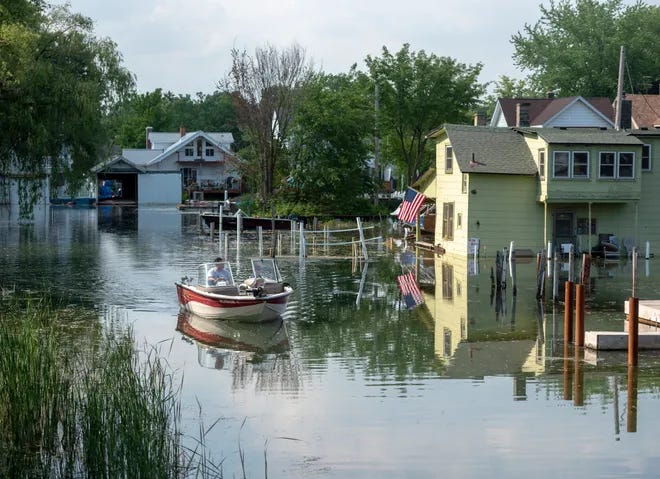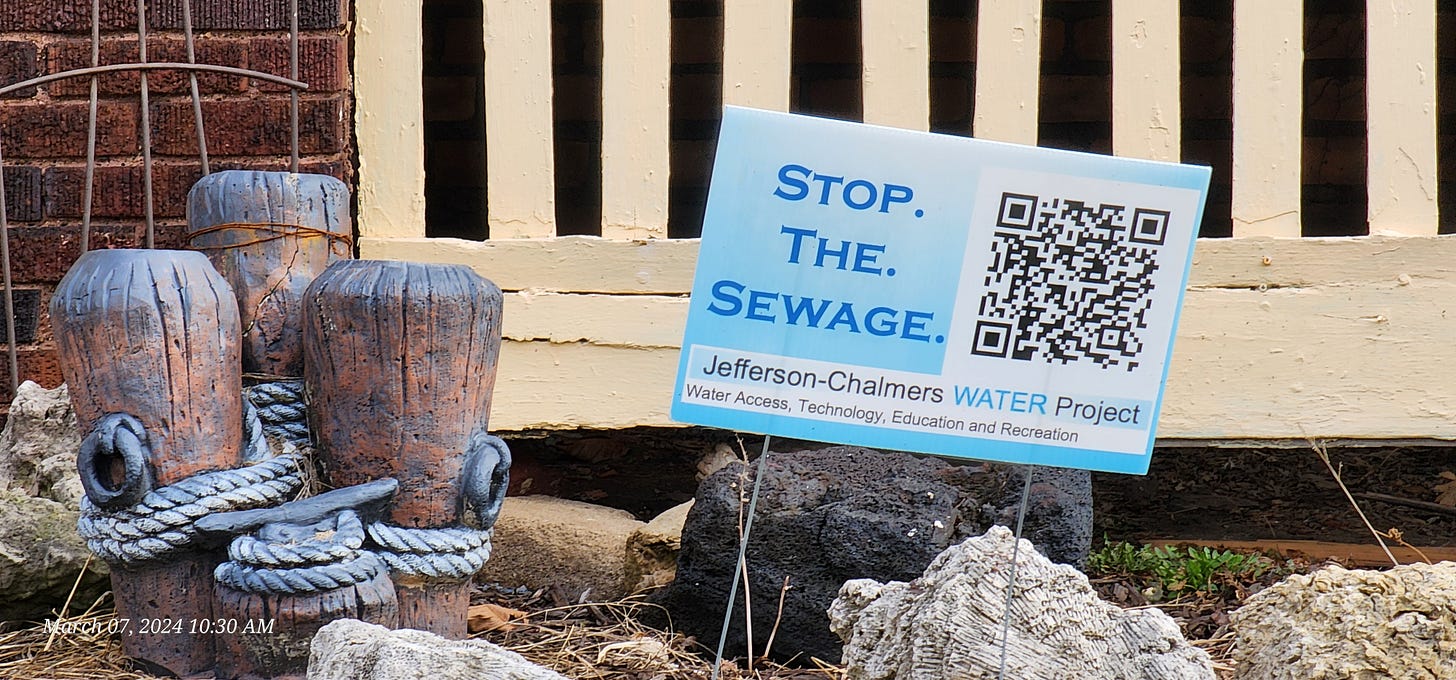In 2023–2024 I worked in disaster recovery efforts[1] in low-income Chicago and Detroit neighborhoods repeatedly impacted by torrential rains and flooding. Here is a playlist to accompany this report.
Title | Artist | Album | Composer | Label
After the Rain | Anat Cohen | Notes from the Village | John Coltrane | Anzic
Flood in Franklin Park | Tom Bennecke | Dub Guerrilla | Shelton Laster | Enja
River Run | Stefano Battaglia | In the Morning | Stefano Battaglia | ECM
The Water | Julia Hulsmann Quartet | In Full View | Leslie Feist | ECM
Muddy Water (A Mississippi Moan) | Bessie Smith | The Collection | Bessie Smith | Columbia
Back Water Blues | Lonnie Johnson | Blues and Ballads | Bessie Smith | Craft
Louisiana 1927 | Randy Newman | Good Old Boys | Randy Newman | Reprise-Rhino
High Water (for Charley Patton) | Bob Dylan | Love and Theft | Bob Dylan | Columbia
River Jordan | Ashley Jackson | Take Me to the Water | Ashley Jackson | Decca
The Water Is Wide | Charles Lloyd Quartet | Mirror | Traditional Scottish | ECM
Headlines often frame excessive heat, rising sea levels, flooding, hurricanes, extended drought, deforestation, and massive wildfires in apocalyptic terms. But less catastrophic extreme weather events already are impacting the daily lives of millions.
The environmental challenges associated with the shifting geography and character of U.S. poverty[2] are such that, as the DHS Science and Technology Directorate noted in 2024, “inequity IS the disaster” in many instances.[3]
Much climate coverage has focused on Florida, Louisiana, and Texas,[4] but across the Great Lakes region, extreme rainfall events have brought record flooding in U.S.-Canadian border cities including Milwaukee, Chicago, Gary, Detroit, Windsor, Toledo, Cleveland, Erie, Buffalo, Hamilton, Toronto, and Kingston.[5]
Following intense rains and associated tornados in the Chicago and Detroit environs, FEMA’s 2023–2024 federal disaster response and recovery efforts in Cook County, Illinois, and Wayne County, Michigan exemplify the impact on low-income urban communities in waterfront centers of the Great Lakes.
Decaying roads and public transportation; deferred infrastructure maintenance; underfunded education, public pensions, police, fire, emergency, healthcare, and social services; chronic unemployment; high utility, insurance, and loan rates; political patronage, corruption; housing shortage, mortgage redlining, foreclosure, property speculation, tax scavenging, absentee landlords, and property abandonment all complicate the response to urban flooding.
Elevated water tables and aging drainage systems in low-lying communities built on lakeshore and marshland claypan make for endemic flooding. In a built landscape dominated by interstate highways, railroad switch yards, power lines, and industrial ventures, increasingly frequent and intense torrential rains inordinately impact low-lying urban areas. Engineered flood-control waterways are typically built to protect big public infrastructure without factoring in the life quality of surrounding low-income neighborhoods.[6]
Five of the Chicago area’s ten recorded wettest years have occurred since 2001.[7] The Illinois Climate Assessment forecasts mounting extreme heat and precipitation, with dire implications for human health and habitation, hydrology, and ecosystem sustainability. Likewise for Detroit, the National Weather Service reports a marked increase in annual rainfall totals, storm incidence, and rain intensity since 1970.[8]
Multi-generation households face myriad socioeconomic challenges exacerbated by a shrinking tax base, deficient governance, and the underfunded public employee pensions. The Great Recession, COVID lockdown, health vulnerabilities, an affordable housing shortage, strained municipal and social services, and a predominance of low-wage service jobs are core concerns of community grassroots politics and local government.
Heavy rains bring residents into the streets, using rakes and brooms to clear gutters and storm drains to prevent pooling flood water from washing over yards and into garages and basements. Flooding damages residences, motor vehicles, businesses, roads, underpasses, sewer systems, and storm drainage, causing soil erosion and flushing trash, human waste, and pollutants into waterways, impacting parklands, nature preserves, urban forests, and wildlife.
Chronic municipal sewer backups compromise health, making mold allergy and asthma endemic health issues. Flooding also exacerbates homelessness given an affordable housing shortage; residents often house relatives in their basements or lease to others to offset rent or mortgage costs. Few homeowners can afford widely advertised basement waterproofing and sewage-backup remediation services that testify to the frequency of local flooding.
FEMA recognizes that community resilience and solidarity are key to forging an integrated response to weather catastrophe, developing effective emergency planning, hazard mitigation, and a coordinated municipal, state, and federal disaster recovery response.
The nonprofit Center for Neighborhood Technology (CNT) secured a $6M Cook County grant for six Chicago Southland towns to create the RainReady Calumet Corridor, in the area where Barack Obama was a community organizer before heading to law school. The project has engaged over 2,000 residents, business owners, elected officials, municipal staff, and NGOs to implement green stormwater infrastructure. Mitigation utilizes open space, bioswales, rain gardens, green alleys, permeable pavers, and retention zones to counter inundation and effect natural flood control.[9]
Comparable efforts are underway in low-income Detroit areas. The city’s declaration of bankruptcy in 2013, preceded by white flight and a near collapse of the U.S. auto industry, dramatically undercut property values, and made labor unions and municipal and state employee pension plans political targets to justify austerity. Detroit public employees took a pension cut, and lost cost-of-living adjustments and health care coverage.[10] During Covid–19, the American Rescue Plan Act included some relief for private pensions, but denied funding to buttress public pension plans.
As elsewhere, Detroit’s sewer system commingles stormwater drainage and human waste during flooding events that overwhelm aging municipal drainage, triggering street flooding, basement sewage backups, and polluted wastewater that empties into the Rouge and Detroit Rivers.
The Michigan Department of Environmental Quality directed Detroit to draft a comprehensive green stormwater infrastructure plan. It has entailed demolition and removal of vacant structures, routing downspout water to landscaped areas, eliminating or replacing paved parking lots with permeable paving and bioretention islands, creating community gardens on vacant lots, planting trees, and creating roadway and parking lot bioswales.
In designated FEMA flood zones Detroit mandates stormwater management for both new construction and redevelopment projects.[11] One such area is Jefferson Chalmers, “a unique, historic neighborhood oriented around a canal system and waterfront parks, built on the vast swamps that once lined the Detroit River and Great Lakes.”[12] The city requires seawall maintenance and flood insurance coverage for residents, who bear the cost of recurrent catastrophic rains, basement sewage flooding, inundated streets, vehicle loss, and utility outages
The Jefferson Chalmers Water Project grassroots community group has called for major investment in stormwater infrastructure, including the creation of wetlands and levees on the Detroit River, a comprehensive neighborhood drainage system, and new canal seawalls to mitigate against future losses. Citing the issue’s systemic nature, the plan would shift mitigation costs from individual owners to the public sector. As some suggest, a managed retreat via residential buyouts might also help to return the area to something approximating its original wetland conditions.
FEMA’s recently revised National Flood Insurance Program offers mitigation grants to support innovative response initiatives. However, current debate on FEMA’s future may limit federal support for climate-change mitigation initiatives.
Yet the National Institute of Building Sciences calculates that every dollar spent on smart design and public-sector mitigation saves $7 against future flood damage. This argues for shrewd investments that prioritize human safety, health, and quality of life, to reduce personal and business loss, strengthen local economies, and protect built and natural environments.[13]
Practical, scalable, cost-efficient strategies exist to foster disaster preparation, mitigation, and community resilience. Confronting imminent and ever more extreme weather events can foster durable solutions while reinforcing broadly shared cultural, social, economic, and environmental values. For an egalitarian approach to redressing climate threats to citizen welfare in high-impact urban environments, political will, grassroots engagement, and recognizing that urban flooding is not a partisan issue are critical to envision, design, fund, and actualize these objectives.
[1] The views expressed here are my own, not FEMA’s.
[2] Kneebone, Elizabeth. The Changing Geography of U.S. Poverty. Testimony before the House Ways & Means Committee, Subcommittee on Human Resources, 15 February 2017, The Brookings Institution brookings.edu/articles/the-changing-geography-of-us-poverty/.
[3] U.S. Department of Homeland Security, Science & Technology Directorate. Inequity IS the Disaster, 22 April 2024, https://www.dhs.gov/science-and-technology/news/2024/04/22/feature-article-inequity-is-disaster.
[4] Chris Mooney; Brady Dennis; Kevin Crowe; John Muyskens. The Drowning South: Where Seas Are Rising at Alarming Speed. Washington Post, 29 April 2024.
[5] The Great Lakes constitute one of the world’s largest surface freshwater ecosystems, comprising 84% of North America’s surface fresh water and 21% of the total global supply. See: U.S. Environmental Protection Agency. Great Lakes Facts and Figures. https://www.epa.gov/greatlakes/great-lakes-facts-and-figures, 17 March 2025.
[6] Lydersen, Kari. Inundation and Injustice: Flooding Presents a Formidable Threat to the Great Lakes Region. Inside Climate News, 8 August 2023, https://insideclimatenews.org/news/08082023/inundated-great-lakes-flooding-midwest/.
[7] National Weather Service, Chicago Annual Temperature and Precipitation Records, weather.gov/lot/chicago_climate_records; cf. NOAA National Centers for Environmental Information, Monthly National Climate Report, February 2023, ncei.noaa.gov/access/monitoring/monthly-report/national/202302.
[8] Wuebbles, D.; Angel, J.; Petersen, K.; Lemke, A.M. (2021): An Assessment of the Impacts of Climate Change in Illinois. University of Illinois at Urbana-Champaign, doi.org/10.13012/B2IDB-1260194_V1; Campa, Aydali. Record-Breaking Rains in Chicago Underscore the Urgency of Flood Resiliency Projects, City Officials Say. Inside Climate News, 28 July 2023, https://insideclimatenews.org/news/28072023/record-rain-chicago-flood-resiliency/; National Weather Service. Detroit/Pontiac Southeast Michigan Climate Information, weather.gov/dtx/decadetable.
[9] McDonald, Maia. Low-income Chicago Suburbs Eye ‘RainReady’ Investments to Limit Flooding, Borderless Magazine, 15 August 2023, wisconsinwatch.org/2023/08/low-income-chicago-suburbs-eye-rainready-investments-to-limit-flooding/; Center for Neighborhood Technology. RainReady Calumet Corridor Plan, cnt.org/projects/rainready-calumet-corridor.
[10] Zaloom, Caitlin. The Broken Promise of Retirement. New York Review of Books. 1 July 2021.
[11] City of Detroit. Green Stormwater Infrastructure Projects, https://detroitmi.gov/departments/water-and-sewerage-department/dwsd-projects/green-stormwater-infrastructure-projects; cf. Detroit Stormwater Hub, https://detroitstormwater.org/projects.
[12] Allnutt, Brian. “Venice of Detroit”: Climate Costs Imperil Historic Neighborhood. The Guardian. 11 August 2023.
[13] FEMA Fact Sheet: Natural Hazard Mitigation Saves, Interim Report, June 2018, https://www.iccsafe.org/wp-content/uploads/NIBS_MSv2-2018_Interim-Report-summary.pdf; Flood Mitigation Assistance Grant Program, fema.gov/grants/mitigation/flood-mitigation-assistance.
















Share this post